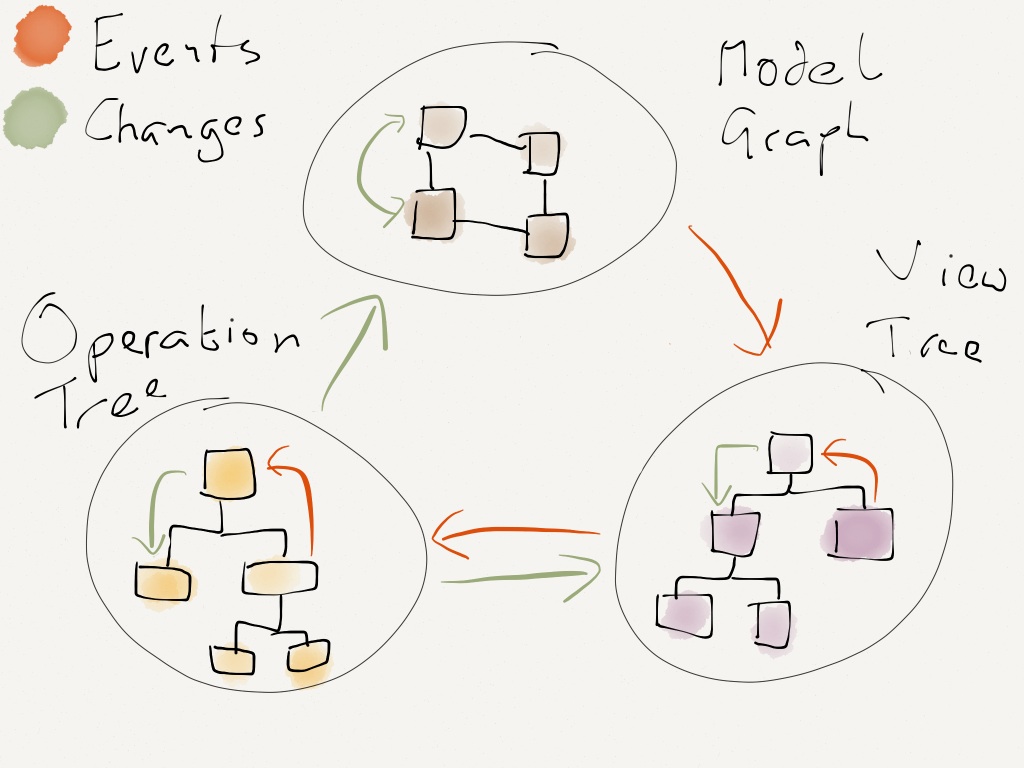MVC is a phenomenal idea. You have models, which are nice self-contained bits of state, views which are nice self-contained bits of UI, and controllers which are nice self-contained bits of …
What?
I'm certainly not the first person to notice this, but the problem with MVC as given is that you end up stuffing too much code into your controllers, because you don't know where else to put it.
To fix this I've been using a new pattern: MOVE. Models, Operations, Views, and Events.
Overview

I'll define the details in a minute, but this diagram shows the basic structure of a MOVE application.
- Models encapsulate everything that your application knows.
- Operations encapsulate everything that your application does.
- Views mediate between your application and the user.
- Events are used to join all these components together safely.
In order to avoid spaghetti code, it's also worth noting that there are recommendations for what objects of each type are allowed to do. I've represented these as arrows on the diagram. For example, views are allowed to listen to events emitted by models, and operations are allowed to change models, but models should not refer to either views or operations.
Models
The archetypal model is a "user" object. It has at the very least an email address, and probably also a name and a phone number.
In a MOVE application models only wrap knowledge. That means that, in addition to getters and setters, they might contain functions that let you check "is this the user's password?", but they don't contain functions that let you save them to a database or upload them to an external API. That would be the job of an operation.
Operations
A common operation for applications is logging a user in. It's actually two sub-operations composed together: first get the email address and password from the user, second load the "user" model from the database and check whether the password matches.
Operations are the doers of the MOVE world. They are responsible for making changes to your models, for showing the right views at the right time, and for responding to events triggered by user interactions. In a well factored application, each sub-operation can be run independently of its parent; which is why in the diagram events flow upwards, and changes are pushed downwards.
What's exciting about using operations in this way is that your entire application can itself be treated as an operation that starts when the program boots. It spawns as many sub-operations as it needs, where each concurrently existing sub-operation is run in parallel, and exits the program when they are all complete.
Views
The login screen is a view which is responsible for showing a few text boxes to the user. When the user clicks the "login" button the view will yield a "loginAttempt" event which contains the username and password that the user typed.
Everything the user can see or interact with should be powered by a view. They not only display the state of your application in an understandable way, but also simplify the stream of incoming user interactions into meaningful events. Importantly views don't change models directly, they simply emit events to operations, and wait for changes by listening to events emitted by the models.
Events
The "loginAttempt" event is emitted by the view when the user clicks login. Additionally, when the login operation completes, the "currentUser" model will emit an event to notify your application that it has changed.
Listening on events is what gives MOVE (and MVC) the inversion of control that you need to allow models to update views without the models being directly aware of which views they are updating. This is a powerful abstraction technique, allowing components to be coupled together without interfering with each other.
Why now?
I don't wish to be misunderstood as implying that MVC is bad; it truly has been an incredibly successful way to structure large applications for the last few decades. Since it was invented however, new programming techniques have become popular. Without closures (or anonymous blocks) event binding can be very tedious; and without deferrables (also known as deferreds or promises) the idea of treating individual operations as objects in their own right doesn't make much sense.
To re-iterate: MVC is awesome, but it's designed with decades old technologies. MOVE is just a update to make better use of the new tools we have.
P.S. I'm not the only one beginning to think this way either, if you like the idea of MOVE you should check out
objectify and
interactions which try to add some of the benefits of MOVE to existing MVC applications. Please
let me know if you have other links that should be here!
P.P.S This blog post has been translated into Japanese no fewer than twice:
d.hatena.ne.jp and
blog.neo.jp. Thanks!
分享到:










相关推荐
资源内项目源码是来自个人的毕业设计,代码都测试ok,包含源码、数据集、可视化页面和部署说明,可产生核心指标曲线图、混淆矩阵、F1分数曲线、精确率-召回率曲线、验证集预测结果、标签分布图。都是运行成功后才上传资源,毕设答辩评审绝对信服的保底85分以上,放心下载使用,拿来就能用。包含源码、数据集、可视化页面和部署说明一站式服务,拿来就能用的绝对好资源!!! 项目备注 1、该资源内项目代码都经过测试运行成功,功能ok的情况下才上传的,请放心下载使用! 2、本项目适合计算机相关专业(如计科、人工智能、通信工程、自动化、电子信息等)的在校学生、老师或者企业员工下载学习,也适合小白学习进阶,当然也可作为毕设项目、课程设计、大作业、项目初期立项演示等。 3、如果基础还行,也可在此代码基础上进行修改,以实现其他功能,也可用于毕设、课设、作业等。 下载后请首先打开README.txt文件,仅供学习参考, 切勿用于商业用途。
《基于YOLOv8的智慧社区独居老人生命体征监测系统》(包含源码、可视化界面、完整数据集、部署教程)简单部署即可运行。功能完善、操作简单,适合毕设或课程设计
Android Studio Meerkat 2024.3.1 Patch 1(android-studio-2024.3.1.14-mac.dmg)适用于macOS Intel系统,文件使用360压缩软件分割成两个压缩包,必须一起下载使用: part1: https://download.csdn.net/download/weixin_43800734/90557060 part2: https://download.csdn.net/download/weixin_43800734/90557056
侧轴承杯加工工艺编制及夹具设计.zip
NASA数据集锂电池容量特征提取(Matlab完整源码和数据) 作者介绍:机器学习之心,博客专家认证,机器学习领域创作者,2023博客之星TOP50,主做机器学习和深度学习时序、回归、分类、聚类和降维等程序设计和案例分析,文章底部有博主联系方式。从事Matlab、Python算法仿真工作8年,更多仿真源码、数据集定制私信。
板料折弯机液压系统设计.zip
C6150车床的设计.zip
机器学习之KNN实现手写数字
python爬虫;智能切换策略,反爬检测机制
mpls-vpn-optionA-all
56tgyhujikolp[
GB 6442-86企业职工伤亡事故调查分析规则.pdf
汽车液压式主动悬架系统的设计().zip
2000-2024年各省专利侵权案件结案数数据 1、时间:2000-2024年 2、来源:国家知识产权J 3、指标:专利侵权案件结案数 4、范围:31省 5、用途:可用于衡量知识产权保护水平
资源内项目源码是来自个人的毕业设计,代码都测试ok,包含源码、数据集、可视化页面和部署说明,可产生核心指标曲线图、混淆矩阵、F1分数曲线、精确率-召回率曲线、验证集预测结果、标签分布图。都是运行成功后才上传资源,毕设答辩评审绝对信服的保底85分以上,放心下载使用,拿来就能用。包含源码、数据集、可视化页面和部署说明一站式服务,拿来就能用的绝对好资源!!! 项目备注 1、该资源内项目代码都经过测试运行成功,功能ok的情况下才上传的,请放心下载使用! 2、本项目适合计算机相关专业(如计科、人工智能、通信工程、自动化、电子信息等)的在校学生、老师或者企业员工下载学习,也适合小白学习进阶,当然也可作为毕设项目、课程设计、大作业、项目初期立项演示等。 3、如果基础还行,也可在此代码基础上进行修改,以实现其他功能,也可用于毕设、课设、作业等。 下载后请首先打开README.txt文件,仅供学习参考, 切勿用于商业用途。
内容概要:本文档详细复现了金融数学课程作业,涵盖欧式看涨期权定价和投资组合优化两大部分。对于欧式看涨期权定价,分别采用Black-Scholes模型和蒙特卡洛方法进行了计算,并对彩虹期权进行了基于最大值的看涨期权定价。投资组合优化部分则探讨了最小方差组合、给定收益的最小方差组合、最大效用组合以及给定风险的最大收益组合四种情形,还对比了拉格朗日乘数法和二次规划求解器两种方法。文中不仅提供了详细的MATLAB代码,还有详尽的中文解释,确保每一步骤清晰明了。 适合人群:金融工程专业学生、量化分析师、金融数学爱好者。 使用场景及目标:①帮助学生理解和掌握金融衍生品定价的基本原理和方法;②为从事量化分析的专业人士提供实用工具和技术支持;③作为教学材料辅助高校教师讲授相关内容。 其他说明:文档还包括了完整的论文结构建议,从封面页到结论,再到附录,涵盖了所有必要元素,确保提交的作业符合学术规范。此外,还特别强调了数据预处理步骤,确保代码可以顺利运行。
脉冲电解射流加工喷射装置设计(1)
ThinkPad S1 (2nd Generation) 和ThinkPad Yoga 260 用户指南V3.0,包含如何拆机更换硬件
charles描述文件下载
python代码-使用人类对话数据集lora微调deepseek